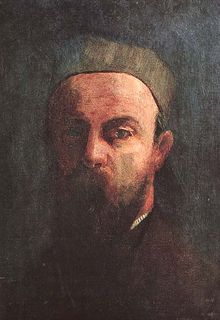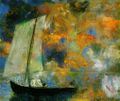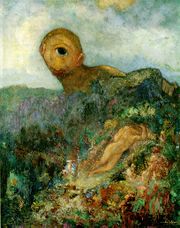Odilon Redon
| Odilon Redon | |
|---|---|
 Self-Portrait, 1880, Musée d'Orsay |
|
| Birth name | Bertrand-Jean Redon |
| Born | 20 April 1840 Bordeaux, France |
| Died | 6 July 1916 (aged 76) Paris, France, |
| Field | painting, engraving, drawing |
| Training | Átelier of Jean-Léon Gérôme |
| Movement | Post-Impressionism, Symbolism |
Bertrand-Jean Redon, better known as Odilon Redon (April 20, 1840 – July 6, 1916) was a French Symbolist painter, printmaker, draughtsman and pastellist.
Contents |
Life
Odilon Redon (pronounced o dee lawn r'dawn) was born in Bordeaux, Aquitaine to a prosperous family. The young Bertrand-Jean Redon acquired the nickname "Odilon" from his mother, Odile.[1] Redon started drawing as a child, and at the age of ten he was awarded a drawing prize at school. Aged fifteen, he began the formal study of drawing, but on the insistence of his father he changed to architecture. His failure to pass the entrance exams at Paris’ École des Beaux-Arts ended any plans for a career as an architect, although he briefly studied painting there under Jean-Léon Gérôme in 1864.
Back home in his native Bordeaux, he took up sculpture, and Rodolphe Bresdin instructed him in etching and lithography. His artistic career was interrupted in 1870 when he joined the army to serve in the Franco-Prussian War.
At the end of the war, he moved to Paris, working almost exclusively in charcoal and lithography. He called his visionary works, conceived in shades of black, his noirs. It would not be until 1878 that his work gained any recognition with Guardian Spirit of the Waters, and he published his first album of lithographs, titled Dans le Rêve, in 1879. Still, Redon remained relatively unknown until the appearance in 1884 of a cult novel by Joris-Karl Huysmans titled, À rebours (Against Nature). The story featured a decadent aristocrat who collected Redon's drawings.
In the 1890s, pastel and oils became his favored media, and he produced no more noirs after 1900. In 1899, he exhibited with the Nabis at Durand-Ruel's. In 1903 he was awarded the Legion of Honor.[2] His popularity increased when a catalogue of etchings and lithographs was published by André Mellerio in 1913 and that same year, he was given the largest single representation at the New York Armory Show.
Redon died on July 6, 1916. In 1923 Mellerio published: Odilon Redon: Peintre Dessinateur et Graveur. An archive of Mellerio's papers is held by the Ryerson & Burnham Libraries at the Art Institute of Chicago.
In 2005 the Museum of Modern Art launched an exhibition entitled "Beyond The Visible", a comprehensive overview of Redon's work showcasing more than 100 paintings, drawings, prints and books from The Ian Woodner Family Collection. The exhibition ran from October 30, 2005 to January 23, 2006.[3]
Analysis of his work

The mystery and the evocation of the drawings are described by Huysmans in the following passage:
- "Those were the pictures bearing the signature: Odilon Redon. They held, between their gold-edged frames of unpolished pearwood, undreamed-of images: a Merovingian-type head, resting upon a cup; a bearded man, reminiscent both of a Buddhist priest and a public orator, touching an enormous cannon-ball with his finger; a spider with a human face lodged in the centre of its body. Then there were charcoal sketches which delved even deeper into the terrors of fever-ridden dreams. Here, on an enormous die, a melancholy eyelid winked; over there stretched dry and arid landscapes, calcinated plains, heaving and quaking ground, where volcanos erupted into rebellious clouds, under foul and murky skies; sometimes the subjects seemed to have been taken from the nightmarish dreams of science, and hark back to prehistoric times; monstrous flora bloomed on the rocks; everywhere, in among the erratic blocks and glacial mud, were figures whose simian appearance--heavy jawbone, protruding brows, receding forehead, and flattened skull top--recalled the ancestral head, the head of the first Quaternary Period, the head of man when he was still fructivorous and without speech, the contemporary of the mammoth, of the rhinoceros with septate nostrils, and of the giant bear. These drawings defied classification; unheeding, for the most part, of the limitations of painting, they ushered in a very special type of the fantastic, one born of sickness and delirium."[4]
Redon also describes his work as ambiguous and undefinable:
- "My drawings inspire, and are not to be defined. They place us, as does music, in the ambiguous realm of the undetermined."[5]
Redon's work represent an exploration of his internal feelings and psyche. He himself wanted to "place the visible at the service of the invisible"; thus, although his work seems filled with strange beings and grotesque dichotomies, his aim was to represent pictorially the ghosts of his own mind. A telling source of Redon's inspiration and the forces behind his works can be found in his journal A Soi-même (To Myself). His process was explained best by himself when he said:
- "I have often, as an exercise and as a sustenance, painted before an object down to the smallest accidents of its visual appearance; but the day left me sad and with an unsatiated thirst. The next day I let the other source run, that of imagination, through the recollection of the forms and I was then reassured and appeased."
Selected works
 Spirit of the Forest, 1880. |
 Cactus Man, 1881. |
 The Crying Spider, 1881. |
 Saint John, 1892. |
|
Lady of the Flowers, c. 1890-95, Honolulu Academy of Arts |
 Flower Clouds, 1903, The Art Institute of Chicago. |
 The Buddha, 1904 |
Saint Sebastian, 1910–1912, National Gallery of Art |
 Coquille, 1912. |
 The Cyclops, 1914 (?), Kroller-Muller Museum, Otterlo, The Netherlands |
 Composition: Flowers, undated, private collection |
 Evocation, undated, private collection |
See also
- Les Nabis
- Maurice Denis
References
- ↑ Online Essay on Odilon Redon
- ↑ Redon and Werner (1969), p. ix.
- ↑ Danielle O'Steen (November 2005). Dark Dreamer. ART + AUCTION. http://www.artinfo.com/news/story/1458/dark-dreamer/. Retrieved 2008-05-20
- ↑ Huysmans, Joris-Karl (1998). Against Nature. Translated by Margaret Mauldon, Oxford University Press. pp. 52–53. ISBN 0140440860.
- ↑ Goldwater, Robert; Marco Treves, Marco (1945). Artists on Art. Pantheon. pp. 360. ISBN 0394709004.
Bibliography
- Russell T. Clement, Four French Symbolists: A Sourcebook on Pierre Puvis de Chavannes, Gustave Moreau, Odilon Redon, and Maurice Denis, Greenwood Press, 1996, ISBN 0313297525 & ISBN 978-0313297526
- Jodi Hauptman and Marina Van Zuylen, Beyond the Visible: The Art of Odilon Redon, 2005, ISBN 0870707027 & ISBN 978-0870707025
- Andre Mellerio, Odilon Redon, 1968, ASIN B0007DNIKO
- Odilon Redon and Alfred Werner, The Graphic Works of Odilon Redon, Dover, 1969, ISBN 0486219968
- Odilon Redon and Alfred Werner, The Graphic Works of Odilon Redon, (Dover Pictorial Archive), 2005, ISBN 048644659X & ISBN 978-0486446592
- Margret Stuffmann, Odilon Redon: As in a Dream, 2007, ISBN 377571894X & ISBN 978-3775718943
External links
- odilonredon.net - Online biography and pictures of Odilon Redon
- Artcyclopedia - Links to Redon's works
- The Athenaeum - Extensive list and images of Redon's works
- Museum Syndicate - Odilon Redon Gallery at Museum Syndicate
- Web Museum - Biography and images of Redon's works
- MoMA Exhibition - "Beyond the Visible - The Art of Odilon Redon" - MoMA exhibition (October 2005 - January 2006)
- www.odilon-redon.org - Site with 322 images by Odilon Redon
|
|||||||||||||||||||||||